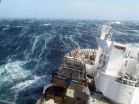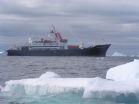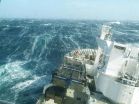(Press-News.org) Researchers at Scripps Institution of Oceanography at UC San Diego have released details of a deep-sea site roughly 48 kilometers (30 miles) west of Del Mar (just north of San Diego, Calif.) where methane is seeping out of the seafloor, the first such finding in the region.
Scripps graduate students on a 2012 UC Ship Funds Program expedition aboard Scripps's research vessel Melville off San Diego County discovered the "Del Mar Seep" during the San Diego Coastal Expedition. Such methane seeps are fascinating environments because of their extraordinary chemical features, at times with bubbling methane streams, and often inhabited by odd and uniquely adapted creatures.
In 2013 the researchers returned to the site, at 1,020 meters (3,346 feet) depth, with a remotely operated vehicle (ROV) to collect samples that would allow them to compare the site to previously studied methane seeps. The team has issued results of a detailed characterization of the Del Mar Seep ecosystem in the August 2015 issue of the journal Marine Ecology.
"The diversity of habitat types we saw within this one seep was really striking," said Ben Grupe, a Scripps alumnus who led the study. "Some areas featured dense but patchy clam beds, others had sediments covered with bacterial mats, while others had snails and glass sponges living on large carbonate rocks."
The scientists also documented larger fish such as Longspine Thornyheads and Pacific Dover sole as well as lithodid crabs, leading to questions about whether this and other West Coast seeps might collectively influence fisheries and support nearby food webs on the continental margin.
A recent visit by Nautilus Live and the ROV Hercules observed sablefish (black cod), skates, and hagfish in and around the Del Mar Seep. This research cruise, which documented the impressive diversity of deep-sea habitats in Southern California, allowed Scripps researchers to recover experiments that were deployed two years prior. Grupe and Lisa Levin, a Scripps professor and study coauthor, hope to use these ongoing colonization experiments to learn more about how methane seep ecosystems might respond to natural or human-caused disturbances.
Chemical analyses of Del Mar Seep inhabitants, including various snails, worms, and sponges, revealed that some of the organisms are getting their nutrition from microbes that directly consume methane. Grupe says such methane consumption can be thought of as a filter that reduces the amount of methane, a potent greenhouse gas, released from the seafloor to the ocean (chemical tests show that the methane is likely produced by bacteria that consume organic material buried in sediments under the seafloor).
"If the community at this seep is taking up methane and converting it to other forms of carbon, that may be preventing additional methane gas from bubbling up into the wider ocean ecosystem," said Grupe.
As the first methane seep discovered in the region, the scientists say the Del Mar Seep will begin to provide clues about how methane seeps may be connected across vast distances with each other and with other ocean ecosystems.
"Finding a methane seep in our own backyard is a great opportunity for Scripps," said Levin. "There is the potential for more frequent visits and long-term observations, and for greater engagement of the public and students. My hope is that more people will learn about chemosynthesis-based ecosystems like this methane seep. As the ocean warms it is likely that more methane will be released from the seafloor, and seep ecosystems will expand."
INFORMATION:
In addition to Grupe and Levin, coauthors of the paper include Scripps alums Monika Krach, Alexis Pasulka, Jillian Maloney, and Christina Frieder. The San Diego Coastal Expedition was supported by UC Ship Funds, Rick and Patty Elkus, Julia Brown, and Steve Strachan. Grupe was supported by the Stout Foundation and Scripps Institution of Oceanography, and Krach was supported by the Secoy Foundation.
Many of the drugs we take today to treat pain, fight cancer or thwart disease were originally identified in plants, some of which are endangered or hard to grow. In many cases, those plants are still the primary source of the drug.
Now Elizabeth Sattely, an assistant professor of chemical engineering at Stanford, and her graduate student Warren Lau have isolated the machinery for making a widely used cancer-fighting drug from an endangered plant. They then put that machinery into a common, easily grown laboratory plant, which was able to produce the chemical. The technique ...
The Southern Ocean has begun to absorb more atmospheric carbon dioxide (CO2) according to new research from an international team, including the University of East Anglia.
A decade ago scientists announced that the amount of CO2 being absorbed by the Southern Ocean had not increased since the late 1980s. And it was feared that this 'carbon sink' might have begun to saturate.
But new research to be published tomorrow (Friday) in the journal Science reveals that rather than stalling, the amount of CO2 being absorbed is on the rise again.
It is thought that changes ...
This news release is available in Japanese.
Inconveniently, the only current method to synthesize the chemotherapy agent etoposide is by using extracts from a plant, but researchers have successfully manipulated Nicotiana benthamiana (tobacco) to create a more immediate and potent precursor. Etoposide is a topoisomerase inhibitor used to treat a variety of malignancies, including lung cancer and leukemia. There is currently no way to produce etoposide without one of its precursors, podophyllotoxin, which is found in the slow-growing Himalayan Mayapple plant. Four ...
This news release is available in Japanese.
In this Policy Forum, Jonas Meckling et al. discuss the need to close the gap between climate science and policy, arguing that targeted policies and economic incentives are the answer, rather than broad carbon taxes. As policymakers convene at the United Nations Climate Change Conference in December, pinpointing the best policies is critical for a more sustainable future. In theory carbon pricing poses as an efficient solution, but this has yet to be seen in practice. As the authors point out, carbon regulation imposes costs ...
This news release is available in Japanese.
Patients with metastatic melanoma who have benefited from a new type of cancer immunotherapy don't appear to share the same tumor-produced antigens, according to a new report by Eliezer Van Allen and colleagues. If the molecular targets for the immunotherapy differ from patient to patient, as this study suggests, it may be difficult to predict which patients will respond to the treatment. The drug, called ipilimumab, is part of a relatively new class of cancer treatments called immune checkpoint inhibitors. The inhibitors ...
This news release is available in Japanese.
The Southern Ocean has increased its uptake of atmospheric carbon dioxide again, after showing signs of slowing uptake in the 1990s, according to a new report from Peter Landschützer and colleagues. The Southern Ocean is a huge player in carbon sequestration, accounting for up to 40% of oceanic uptake of atmospheric carbon dioxide. When earlier studies showed the Southern Ocean's carbon sink weakening, the findings raised concerns that the planet might lose a powerful way to remove the growing amounts ...
Breathe in, breathe out, in, out... Like a giant lung, the Southern Ocean seasonally absorbs vast amounts of carbon dioxide (CO2) from the atmosphere and releases it back later in the year. But on an annual average the seas surrounding Antarctica absorb significantly more CO2 than they release. Most importantly, these seas remove a large part of the CO2 that human activities emit into the atmosphere, thereby slowing down the growth of this greenhouse gas in the atmosphere, lessening the rate of climate change. Although the Southern Ocean represents no more than a quarter ...
Berkeley -- To speed up progress in tackling climate change, policymakers need to build political support by investing in clean-energy industries rather than first penalizing polluters, according to a new policy paper by researchers at the University of California, Berkeley.
In the paper, to be published Thursday, Sept. 10, in the journal Science, a multidisciplinary team of environmental, political and legal experts finds that instead of emphasizing cap-and-trade schemes and penalties on greenhouse gas emissions - strategies considered to be most efficient by many economists ...
MENLO PARK, Calif. -- Some of the inner workings of Earth's subduction zones and their "megathrust" faults are revealed in a paper published today in the journal Science. U.S. Geological Survey scientist Jeanne Hardebeck calculated the frictional strength of subduction zone faults worldwide, and the stresses they are under. Stresses in subduction zones are found to be low, although the smaller amount of stress can still lead to a great earthquake.
Subduction zone megathrust faults produce most of the world's largest earthquakes. The stresses are the forces acting on ...
Researchers from the MRC Centre for Developmental Neurobiology (MRC CDN) at the Institute of Psychiatry, Psychology & Neuroscience (IoPPN), King's College London, have discovered a new molecular 'switch' that controls the properties of neurons in response to changes in the activity of their neural network. The findings, published in Science, suggest that the 'hardware' in our brain is tuneable and could have implications that go far beyond basic neuroscience - from informing education policy to developing new therapies for neurological disorders such as epilepsy.
Computers ...


